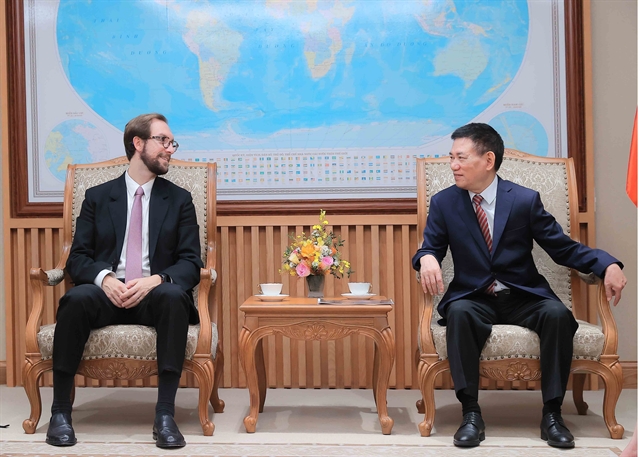 Economy
Economy

National carrier Vietnam Airlines plans to issue more than 191 million shares to current shareholders to fund the purchase of new airplanes and other business activities.
 |
| Passengers check in at Vietnam Airlines counters at the Nội Bài International Airport in Hà Nội. - Photo baogiaothong.vn |
HÀ NỘI – National carrier Vietnam Airlines plans to issue more than 191 million shares to current shareholders to fund the purchase of new airplanes and other business activities.
At the carrier’s annual shareholder meeting on Tuesday, it was said that the 191 million shares with a par value of VNĐ10,000 (44 US cents) per share could be sold in the fourth quarter or at any other time that the management board decides.
Current shareholders will have the right to buy the shares at a rate of 15.5 per cent, meaning that an investor will be able to one additional share for every 15.5 shares he owns at the moment.
Among the additional shares are 164.73 million shares sold to State shareholders and 16.77 million shares issued to the firm’s Japanese strategic investor ANA Holding Inc. Other shareholders will be able to purchase 9.7 million shares.
The share issuance is expected to raise VNĐ1.91 trillion (nearly $85 million), which would help the aviation group cover a part of the cost of purchasing new planes and making payments for its suppliers.
In 2017, Vietnam Airlines plans to spend VNĐ2.1 trillion – 72 per cent of this year’s spending budget – purchasing 10 A350-900WB planes and eight Boeing 787-9 planes.
This year’s business plan also includes VNĐ87.9 trillion in combined revenue, an annual increase of 22.7 per cent.
However, the combined post-tax profit of VNĐ1.33 trillion marks a 35 per cent drop from 2016.
The targeted post-tax profit is lower based on worries about higher fuel costs and rising global oil prices as well as rising amortisation costs generated by the purchase of new planes.
Last year’s post-tax profit was a record high for Vietnam Airlines, supported by oil prices that hit a historical 12-year bottom in mid-January 2016. Crude prices have rebounded about 47.5 per cent since then. This year’s business plan is developed based on a $64 per barrel oil price scenario.
The company also attributed the decline in annual post-tax profit to slow growth of market purchasing power, which is forecast at 9.5 per cent for 2017.
The slow rise in market purchasing power means Vietnam Airlines will have to face a decline in its Revenue per Available Seat Kilometre (RASK) – a term of unit cost used in the aviation industry.
The RASK figure in 2017 is forecast at 5 per cent lower than 2016 and 22 per cent lower than 2015.
Meanwhile, competition is heating up n the international markets as low-cost carriers enhance their presence in Viet Nam and in the Northeast and Southeast Asian regions, traditional markets for Vietnam Airlines.
In addition, the Nội Bài and Tân Sơn Nhất international airports, the biggest in Việt Nam, will undergo repairs and maintenance at the year end. This will reduce business activities in those two airports by 30 per cent and force aviation firms to cut the number of flights to and from those airports by at least 15 per cent during the day.
Share price concerns
Vietnam Airlines also plans to switch listing its shares from the Unlisted Public Company Market (UPCoM) to either the HCM Stock Exchange or the Hà Nội Stock Exchange.
Shares of the company, under code HVN, debuted on UPCoM at VNĐ39,200 per share on January 3. Its share price has lost nearly one-third of its value to close Tuesday at VNĐ26,825.
In comparison, the share price of low-cost carrier Vietjet has risen by 18 per cent to end Tuesday at VNĐ126,500 per share. Vietjet shares debuted on the stock market at the end of February.
Such decline of share price has raised some concerns among the firm’s shareholders about the company’s strength and competence.
According to the firm’s chief accountant, Trần Thanh Hiền, the share price is quite stable and reflects Vietnam Airlines as an aviation company that meets international standards and practices.
Hiền said that the movement of share prices depends on various factors, including business performance, business strategy, market conditions and liquidity.
For some firms, the amount of floating shares is quite small, showing that the company’s stock structure is dense and making share prices low, according to Hiền.
Compared to the low-cost carrier Vietjet, Vietnam Airlines focuses on the high-class segment with provision of high-quality products and services, said general director Dương Trí Thành.
Low-cost carriers have developed strongly in recent years and account for 60 per cent of the domestic market. This sector is expected to grow 20-30 per cent per year in the coming years.
Vietnam Airlines would, therefore, push harder its operation in international markets, he said.
For the domestic market, Vietnam Airlines would concentrate its business on the low-cost segment in co-operation with Jetstar Pacific. The two firms would try to keep their market shares at least 30 per cent, Thành said. – VNS








, MOSTI, YB Tuan Chang Lih Kang Minister of Science, Technology and Innovation (MOSTI), Tuan Fabian Bigar, Secretary General of the Ministry of Digital, and Norman Matthieu Vanhaecke, Group CEO of C)